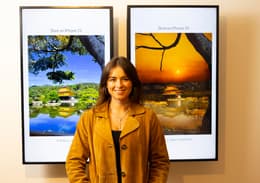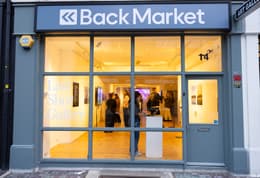The Last Shot Gallery depicts famous locations - including Venice and Central Park - as they will look in the future should we not start cutting global e-waste levels. We took a look around, speaking to artists and even scientists about how art can trigger positive societal shifts.
There are few things more intimate than sailing a gondola with the love of your life under the Rialto Bridge and reaching the soothing canals of a sunny Venice. Yet fast forward 75 years and this setting will potentially be a whole lot different: the Rialto Bridge is now submerged under water; the sky is deathly grey; and smiley tourists have been replaced by algae as well as soggy plastic bags.
This bold depiction of Venice - by artists Archie McGrath and Josiah Naguar - is at the epicentre of Back Market’s Last Shot gallery in Fitzrovia, London, which opened last week. The Last Shot Gallery has let various artists re-imagine stunning locations (including South America’s Iguazu Falls, the Dover Cliffs in England, and Central Park, New York City), examining how each of these could be permanently altered by climate change unless we all take collective action around cutting rising pollution and e-waste levels.
Importantly, these dark visions are backed up by experts, with Mark Maslin, a professor of earth system science at University College London, using sophisticated climate modelling technology to predict the potential damage to each iconic location, subsequently giving artists access to this data to inform their final work.
“The Venice before and after delivers a really sobering image” - Luke Forshaw, head of brand and marketing at Back Market.
Forshaw continues: “In our image of Venice in 2100, the impact of climate change is so blunt and in your face; it’s like all the romance of the place has been stripped away. This potential outcome is terrifying because it is based on science.”
Whether it’s the way Basquiat referenced the AIDS epidemic, or Pablo Picasso's ‘Guernia’ offered a sobering anti-conflict statement amid the Spanish Civil War, the art world has long been a mirror to simmering societal tensions. And the Last Shot Gallery very much continues in this tradition.
Where it really stands out is through its commitment to not looking at things through rose tinted glasses, argues Alice Garrard, the artist who has reimagined the sacred temple of Kinkaku-Ji as an arid place filled with dead trees. “Maybe sometimes artists naturally lean towards imagining a positive outcome,” she explains, “but what made this brief so interesting is it forces you to immerse yourself in the worst possible scenario.
“That’s what makes the Last Shot Gallery so impactful; there’s no hiding away from the bleak future we’re all tempting into existence through our reliance on Fast Tech.” Another one of the gallery’s highlights is artist Hugh Jardine’s haunting depiction of Mount Kilimanjaro, which claims this location will be devoid of colour and plagued by constant tornados should we not reverse climate change by the time the iPhone 90 hits stores.

Artist Alice Garrard with her work at the Last Shot Gallery.
In the artist’s original version an Ostrich was burning to death, but the decision was ultimately made to cut such a dystopian moment. “The idea of these iconic natural locations transforming into symbols of destruction and decay is a very scary thought,” says Jardine. “Viewing our interpretations hopefully moves you enough into wanting to make some positive changes.”
The latter is the primary goal of Back Market’s Last Shot Gallery. For example, by referencing the iPhone 90, the hope is to show visitors how an always upgrade-culture is damaging the planet due to it leading to millions of obsolete devices unnecessarily ending up at e-waste dumps. In 2022, a record 62m tonnes of electronic waste was produced, making it one of the world’s fastest-growing waste streams.
And new research commissioned by Back Market, as part of the Last Shot launch, reveals the true extent at which consumers are witnessing the visible effects of climate change across their daily lives. When asked about changes in nature, nearly four in five UK adults (89%) said they have noticed differences over their lifetime. The top shifts include hotter summers (39%) and more frequent storms and extreme weather events (33%). Additionally, more than one in five (22%) even reported a noticeable change in local wildlife (such as witnessing fewer birds and insects).

Artist Hugh Jardine's work originally showed an ostrich on fire.
Despite all this, only four in ten (41%) say that climate change currently plays an active role in their day-to-day tech-buying choices. These findings highlight how so much more work needs to be done to combat e-waste and change the mindset of the other 59% of consumers, who have been convinced to keep upgrading their devices despite the dire effects on our planet.
“It is important to change the narrative,” agrees Professor Mark Maslin. “The hope is that this gallery can wake up the big tech companies into realising there are different ways of making money than just constantly launching new devices; it's a toxic cycle that is quite literally having a toxic ecological effect. I believe we can create a society where devices are easily repairable and the more environmentally-friendly, refurbished tech sold by retailers like Back Market becomes the mainstream norm.”

How Back Market's Last Shot gallery looks from the outside.
Whatever you end up taking away from Back Market’s Last Shot Gallery, the one thing that’s impossible not to notice is just how much colour is lost in the depiction of our planet towards the end of the 21st century. It is a reminder that if we carry on this same path then our world will quite literally become a darker place; something that will inevitably filter into the aesthetic of artists.
Professor Maslin concludes: “In the future we will have a hotter, drier, dustier world with higher temperatures, while plant life will struggle to survive. Therefore, we’re going to lose that range of colour that makes our planet such a beautiful place and art will naturally become more mundane. Central Park, for example, might very well transform from its famous greens to looking more like something out of [Cormac McCarthy’s post-apocalyptic novel] The Road.
“But even though this is all a very real possibility, my hope is that Last Shot and our Before and After shots can show that it doesn’t have to be like this. Through making better tech choices right now, we can start to reverse some of the bleak forecasts and turn them into more positive ones. The message is: it isn’t too late to change our path!”

